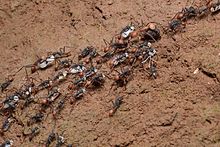Aripuanã marmosets
| Aripuanã marmosets | ||||||||||||
|---|---|---|---|---|---|---|---|---|---|---|---|---|

Aripuanã marmoset ( Mico intermedius ) |
||||||||||||
| Systematics | ||||||||||||
|
||||||||||||
| Scientific name | ||||||||||||
| Mico intermedius | ||||||||||||
| ( Hershkovitz , 1977) |
The Aripuanã marmoset ( Mico intermedius , Syn . : Callithrix intermedia ) is a species of primate from the marmoset family .
features
Aripuanã marmosets, like all marmosets, are relatively small primates. They reach a head-torso length of 20 to 24 cm, have a 32 to 40 cm long tail and reach a weight of approx. 280 (males) to 310 grams (females). Their fur is colored white on the front part of the trunk and turns dark brown towards the back. The hind legs and tail are also reddish brown, and there is a yellow stripe on the thighs. The head is also white, the face is hairless and colored flesh-colored or gray. There are small tufts of ears on the ears. As with all marmosets, the fingers and toes (with the exception of the big toe) have claws instead of nails.
distribution and habitat
Aripuanã marmosets in a small part of the Amazon basin in Brazil . Its distribution area extends between the rivers Rio Aripuanã and Rio Roosevelt in the states of Amazonas and Mato Grosso and is congruent with that of the fire- tailed juggler monkey ( Plecturocebus miltoni ). Their habitat are primary and secondary forests and forest edge areas with dense undergrowth and clearly pronounced rainy (December to March) and dry seasons (May to October). They are rare in riverside, regularly flooded forests and forests with tall trees and little undergrowth. There normally only one group lives on an area of 2 km², while in forests with dense undergrowth there are 3.1 to 4.7 groups per km².
Way of life
These primates are diurnal and sleep in thickets or tree hollows at night. They mainly stay in the trees, where they move four-legged or jumping, but sometimes come to the ground to forage. Aripuanã marmosets live in groups of 8 to 15 animals. The groups are organized around a full-grown pair, there are several females in them, usually 1 to 5 adult females and 1 to 4 adult males, only the dominant female reproduces. Aripuanã marmosets begin their activities about half an hour after sunrise and seek their resting places around 4 p.m., sometimes earlier, especially when it rains. On average, the animals spend 38% of their active time moving, 30% looking for animal food, 18% looking for plant-based food, and 14% resting, social grooming or other social activities. As with all marmosets, dizygoti twins are usually born. The females usually give birth twice a year. The interval between births is 148 to 162 days, so there can be three births in a year. The father and the other group members participate intensively in raising the young, they carry the young and give them to the mother only to suckle.
nutrition
Aripuanã marmosets feed on fruits, with preference for small, sweet fruits, nectar, plant juices and small animals. A group of monkeys observed over a period of 12 months ate fruit from 52 different plant species from 24 families. These include mulberry plants ( figs , fruits of Naucleopsis , Pseudolmedia and Sorocea ), Nettle family ( Cecropia and Pourouma ) burseraceae ( Protium and Tetragastris ), and the legume Inga . The fruits of the ant trees and of Inga and Pourouma are available most of the year or many months of the year and represent a kind of staple food. Ant tree fruits can also be found in the dry season, when the fruits of the other trees are rarely or no longer available. Depending on the season, fruits make up 32 to 94% of the animals' plant-based diet. The proportion of flowers and nectar is between 4.5 and 18%. The flowers and nectar of Symphonia globulifera are particularly important in the dry season when there are few fruits. Tree saps make up 6 to 59% of the plant-based diet of the Aripuanã marmosets. The above-mentioned group of monkeys used 34 plant species from 12 families. 14 of them are legumes (e.g. acacias , diplotropis , Enterolobium , Hymenolobium , Inga , Parkia ), others come from the sumac family ( Anacardium , Spondias and Tapirira ) or the mahogany family ( Trichilia guianensis ).
Depending on the season, Aripuanã marmosets spend a quarter to a third of their active time foraging for animal food. These include frogs, small lizards, spiders and numerous insects, e.g. B. grasshoppers mainly field locusts and leaf locusts , crickets , catching horrors , ghosts , butterflies, beetles, cicadas and other Schnabelkerfe , cockroaches and termites . Occasionally they also come to the ground to look for food in the leaves. If they come across trains of the wandering ant Eciton burchelli, they move to the head of the train to disturb the insects and pick out individual specimens that are leaving the column.
Danger
Parts of the range of this species are affected by massive deforestation. Due to its ability to live in partially cleared forests, the IUCN lists the Aripuanã marmoset as "not endangered" ( least concern ). Due to the Transoceánica , the distribution area of the Aripuanã marmoset has been divided into two parts. There is no protected area in the distribution area.
literature
- Thomas Geissmann : Comparative Primatology. Springer-Verlag, Berlin et al. 2003, ISBN 3-540-43645-6 .
- Don E. Wilson, DeeAnn M. Reeder (Eds.): Mammal Species of the World. A taxonomic and geographic Reference. Johns Hopkins University Press, Baltimore MD 2005, ISBN 0-8018-8221-4 .
supporting documents
- ↑ a b c d e f A. B. Rylands & RA Mittermeier: Family Callitrichidae (Marmosets and Tamarins). in Russell A. Mittermeier , Anthony B. Rylands & Don E. Wilson : Handbook of the Mammals of the World: Primates: 3. (2013) ISBN 978-8496553897 . Page 310 and 311.
- ^ IUCN entry


